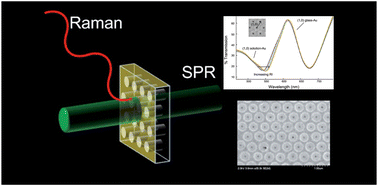Nanohole arrays in chemical analysis: manufacturing methods and applications
Abstract
Since the last decade,

* Corresponding authors
a
Département de Chimie, Université de Montréal, C.P. 6128 Succ. Centre-Ville, Montréal, QC, Canada
E-mail:
jf.masson@umontreal.ca
Fax: +1-514-343-7586
Tel: +1-514-343-7342
b Centre for Self-Assembled Chemical Structures (CSACS), McGill University,, QC, Canada
c Centre for Biorecognition and Biosensors (CBB), McGill University, QC, Canada
Since the last decade,

 Please wait while we load your content...
Something went wrong. Try again?
Please wait while we load your content...
Something went wrong. Try again?
J. Masson, M. Murray-Méthot and L. S. Live, Analyst, 2010, 135, 1483 DOI: 10.1039/C0AN00053A
To request permission to reproduce material from this article, please go to the Copyright Clearance Center request page.
If you are an author contributing to an RSC publication, you do not need to request permission provided correct acknowledgement is given.
If you are the author of this article, you do not need to request permission to reproduce figures and diagrams provided correct acknowledgement is given. If you want to reproduce the whole article in a third-party publication (excluding your thesis/dissertation for which permission is not required) please go to the Copyright Clearance Center request page.
Read more about how to correctly acknowledge RSC content.
 Fetching data from CrossRef.
Fetching data from CrossRef.
This may take some time to load.
Loading related content
